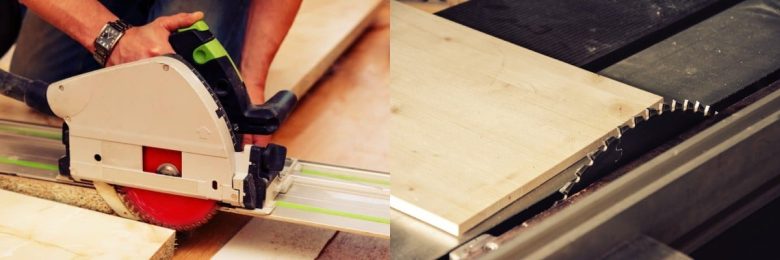Accurate cuts improve the look and function of your woodworking projects. Trying to decide between a table saw and a track saw is a challenge. They produce similar cuts but operate differently.
Let’s take a closer look at both and then compare a couple of designs that might match your needs.
What Do You Need To Know About Table Saws?
When comparing track saws vs table saws, you need to consider the setup. These tools require more space since they are stationary. A table saw does increase productivity since it does not line up on the wood.
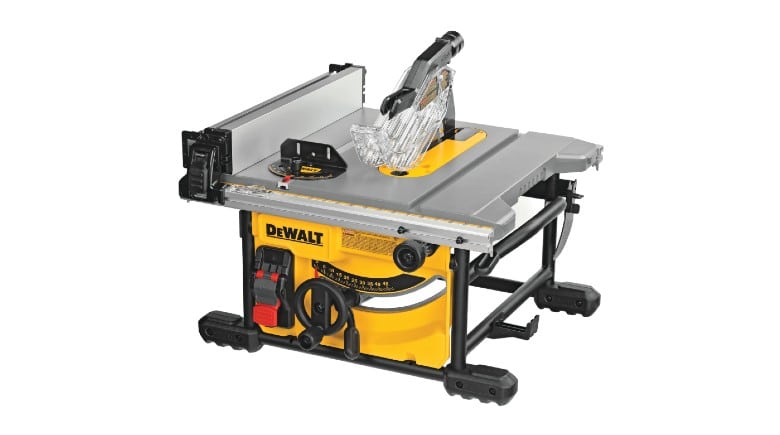
Looking at the various types of table saws
Manufacturers produce a variety of table saw types that cater to hobbyists, professionals, and manufacturing facilities. The options available to you include:
- Benchtop table saws: Compact designs that are easy to move and store are the hallmarks of these small table saws.
- Jobsite table saws: Larger tables, better guides, and folding stands are features that distinguish these from benchtop saws.
- Contractor table saws: Provides more accurate adjustments, motor power, and build materials than those found on smaller products.
- Hybrid table saws: Marketed as a compromise between features found on contractor table saws and cabinet table saws.
- Cabinet table saws: You will pay more but should also get the best cuts and features available.
Is a table saw right for you?
Hobbyists needing accuracy with repeated cuts, especially rip cuts and joinery along the grain, will prefer a table saw. Woodworkers with a dedicated shop space may also prefer the table saw option over a track saw.
Should you avoid buying one?
Woodworkers who will rarely use the table saw might consider different options that will get more use. If you are starting without a dedicated shop space, a miter saw or a circular saw might be a better option for you.
Pros
- Aligning the fence is easier than setting a guide. You will save time here, and it may also be more accurate.
- A table saw proves better dust collection. Port designs are usually better than those found on hand-held tools.
- A table saw is better for repeatable cuts. Once setup is complete, you can make as many cuts as needed.
Cons
- The cutting capacity of a table saw is limited by the fence. This is limited to the space between the blade and the fence.
- A table saw is less mobile. You bring the material to the saw instead of taking the saw to the material.
What Do You Need To Know About Track Saws?
Track saws excel in making long rip cuts, especially in wood that would be difficult or unsafe to bring to your table saw. However, you will need to move the guide if you are making more than one cut.
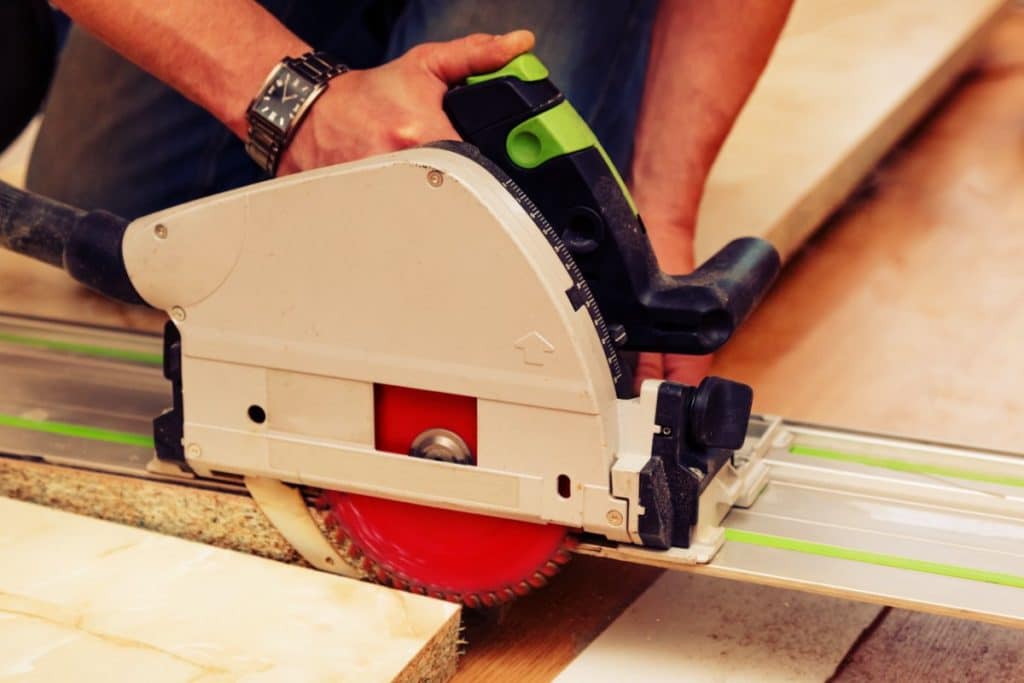
Looking at the various types of track saws
These power tools are a more recent hand-held saw design. This means that your selection will be based more on a product’s features rather than a particular type. Some options worth highlighting here include:
- Track saws: The standard design is also referred to as a plunge saw or plunge-cut saw.
- Cordless track saws: Uses a battery pack for power instead of an outlet, providing you with greater mobility.
- Circular saws with a track guide rail: I mention this here as guides and kits are available for “conversion” into a track saw. A circular saw is less efficient at plunge cutting, making this a poor choice for some woodworkers.
Is a track saw right for you?
This power tool might be a great fit if you need to rip longer boards that may be difficult to control on a table saw. They require less room to set up, which is good for small shops.
Should you avoid buying one?
This will not be the most efficient saw if you make a lot of repeated cuts. Other saws can handle breaking down material or making rough cuts. You might want to read this circular saw review instead.
Pros
- It can cut any width. A fence will not limit capacity.
- These are portable. Cutting larger pieces is quick and safe.
- Does not require a dedicated space. You can cut, move, and store a track saw more easily.
Cons
- It is less efficient with deeper cuts. The table saw often provides more stability and maximum depth.
- You will need to re-align the guide if you are making multiple cuts.
Table Saw vs. Track Saw: Tools Worth Considering
DeWalt DWE7491RS 10-Inch Table Saw
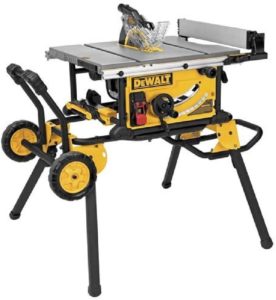
OVERVIEW
You might wonder what you will get with the price tag on the DWE7491RS by DeWalt. This is a professional-grade table saw designed for use on construction sites and in manufacturing shops. It provides a lot of features and has a durable build that will serve your needs for years.
The 10-inch blade can cut to 3 1/8 inches when positioned at 90 degrees. You can get 2 1/4 inch deep cuts when the blade is tilted to 45 degrees. This should be sufficient for most materials used in beginner and intermediate woodworking projects.
DeWalt uses a 15-amp motor designed to provide a higher torque rating. This will allow you to operate at maximum cutting depth in most wood species without bogging down. It will also power a Dado stack up to 13/16 inches.
What stands out about this table saw is the maximum rip capacity of 32.5 inches to the right of the blade. That is wider than most products in this size and category. You can also get 22-inch rip cuts on the left.
Pros
- This table saw has a 32.5-inch rip capacity. That is a wide cutting range for this size of a power tool.
- The DWE7491RS is powered by a high-torque motor. This component maintains a consistent speed at depth in dense woods.
- You can use a dado stack. Many of the smaller table saw designs are not built to use dado blades.
Cons
- The DeWalt DWE7491RS has a big price tag. That may be high for new hobbyists on tighter budgets.
- You may find the rolling stand getting in the way when cutting smaller parts.
DeWalt DWE7485 8-1/4-Inch Table Saw
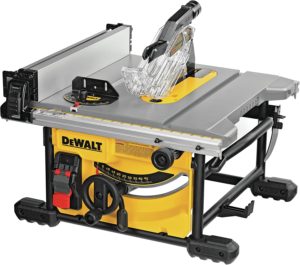
OVERVIEW
Another DeWalt table saw is the DWE7485 model. This unit is smaller than the previous saw, using an 8.25-inch blade. That will let you cut 2 9/16 inches deep at 90 degrees but only to 1 3/4 inches when adjusted to 45 degrees.
This model also uses a 15-amp motor, but it is not the high-torque variation. You will not be able to drive a dado stack effectively, but you should find it acceptable for almost all wood species. It should cut to maximum depth without bogging down.
This table saw is marketed for its portability. It weighs only 46 pounds, making it easier for one person to carry. The smaller dimensions will also allow you to store it under your bench or in a shop cabinet.
That compact size is one of the reasons that DeWalt does not include a stand with this table saw. The DWE7485 is built with quality components, including a strong roll cage that keeps it protected as you move it from place to place.
Pros
- The price is budget-friendly. This is an advantage for tight budgets, especially considering the build quality.
- It includes a rack-and-pinion fence. You can make quick adjustments that are accurate and smooth with this design.
- The DeWalt DWE7485 is lightweight and compact. You can move it by yourself, and it is easy to store.
Cons
- You can not cut as deeply with this table saw. This could require more passes, especially with beveled cuts.
- It is offered without a stand. The DWE7485 is built for shops that have workbenches or a pedestal to mount on.
Makita SP6000J1 6.5-Inch Track Saw & 55-Inch Guide Rail
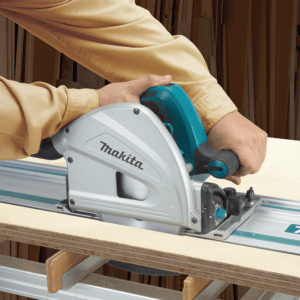
OVERVIEW
Makita designed the SP6000J1 to handle cuts through typical building materials. The 6.5-inch bade cuts to 2 3/16 inches at 90 degrees and 1 9/16 inches at 45 degrees. You can cut through standard framing lumber without a bevel, but beveled cuts will require multiple passes.
A 12-amp electric motor is used to power the track saw, and it is equipped with a soft-start feature that helps to reduce motor wear. This motor size will handle most wood species without bogging down. Makita incorporates electronic controls to maintain a consistent running speed throughout the cut.
You can cut 11/16 inches away from a wall with this track saw. That should prove beneficial to homeowners doing a remodel, as well as professionals installing floors.
Its dust port has an outside diameter of 1 1/2 inches and can be attached to a multitude of shop vac hoses. The location of the exhaust also provides maximum debris removal as the material is pushed towards the opening during the cut.
Pros
- This track saw offers variable speed control. This allows you to match RPMs with the blade, materials, and depth of cut.
- Electronic speed controls are included. It should provide you with a consistent running speed through the entire cut.
- You can get up to 48 degrees with bevel cuts. That is slightly more than the typical 45-degree adjustment.
Cons
- The SP6000J1 has a shallow depth of cut. This can be an issue, especially when making beveled cuts along the edge of boards.
- Makita’s rail system can have alignment issues. Aligning multiple rails can be difficult.
DeWalt DCS520T1 6.5-Inch Cordless Track Saw
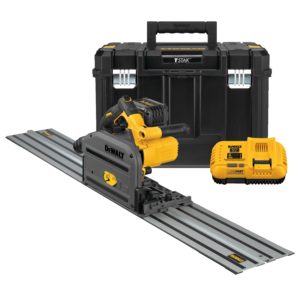
OVERVIEW
The DeWalt DCS520T1 is a complete kit. It does not include a guide rail, but your purchase does include a battery pack and a charger. This is a nice option for those buying their first cordless tool in this battery line.
It uses a 6.5-inch blade design. This can cut 2 1/8 inches deep at 90 degrees and 1 5/8 inch at 45 degrees. That should cut typical two-by-four framing lumber with a single pass.
DeWalt’s trademarked Zero Clearance TrackSaw cutting design generates straight cuts that are accurate and free from splinters. This is a nice addition, as many cuts usually require some clean-up afterward. It also compares favorably with a table saw’s cutting precision.
DeWalt designed the dust extraction to work at angles up to 90 degrees. A lower profile can be advantageous in low-profile spaces. This can be detrimental, however, if the hose drags on the guide or the angle creates more clogging at the elbow.
Pros
- It offers a slightly deeper cutting depth than the Makita. This could save time on your cuts.
- This track saw uses DeWalt’s 60 V Max battery platform. This will provide maximum power for longer periods of runtime.
- A cordless design provides optimal mobility. This is especially useful on construction sites and in tight spaces.
Cons
- This kit does not come with a guide. You have to buy the rails separately from the track saw.
- Its exhaust port is angled down. That can cause the shop vac hose to drag along the guide rail during the cut.
Cutting It Down To Your Needs
Deciding between a track saw and a table saw could come down to your personal preferences. I do feel that matching your typical project needs to the tool will allow you to make the best purchase, though.
If you have limited room or you work with large boards, then a track saw is worth considering. Woodworkers making repeated cuts will benefit greatly from a table saw.
While both provide accurate cuts, I feel the table saw is more precise since fewer adjustments mean fewer errors. If you take your time, it will not matter, as the guide will keep a track saw in place.

